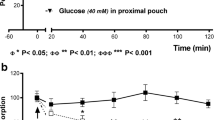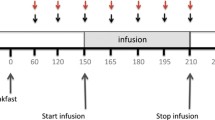Summary
Background: Intraileal carbohydrates and lipids affect the pancreatic exocrine secretion, but the effect of intraileal amino acids and the role of the extrinsic nerves of the ileum as mediators of the pancreatic bicarbonate and enzyme output are unknown.
Methods: Four dogs underwent total extrinsic denervation of the entire ileum. Thomas-like cannulas were placed into the stomach, duodenum (to collect pure pancreatic juice), and at the jejuno-ileal junction. Eight neurally intact control dogs received only the three fistulas. After recovery, in both sets of dogs, dose-response studies of the pancreatic secretory response to intraileal infusion with graded loads of tryptophan (0.12–10.0 mmol/h) were performed, given against an intravenous (iv) background of secretin (20.5 pmol/kg/h) and cerulein (29.6 pmol/kg/h). On separate days, control experiments with intraileal infusion of 0.15 M NaCl were performed.
Results: In both sets of dogs, iv secretin plus cerulein significantly (p<0.05) increased pancreatic bicarbonate and protein output above basal. Intraileal tryptophan caused a dose-dependent decrease in the pancreatic bicarbonate and protein response to secretin plus cerulein. In the dogs with denervated ileum, this inhibition was significantly stronger than in the intact animals. In both sets of dogs, the 225-min integrated bicarbonate (IBR) and protein response (IPR) to all loads of tryptophan were significantly lower than in control experiments. Both IBR and IPR were significantly lower in the denervated as compared with the intact animals.
Conclusions: 1) Extrinsic denervation of the entire ileum is a valuable preparation to study the role of nerves in the control of pancreatic exocrine secretion; 2) both in the intact and denervated animals the amino acid tryptophan induces an “ileal brake” of the hormonally stimulated pancreatic bicarbonate and protein output; 3) the extrinsic nerves of the ileum are probably not the dominant mediators of the inhibitory action of intraileal tryptophan but rather counteract this effect.
Similar content being viewed by others
References
Singer MV. Neurohormonal control of pancreatic enzyme secretion in animals, in The Pancreas: Biology, Pathobiology, and Disease, Go VLW, ed. Raven, New York 1993; pp. 425–448.
Niebergall-Roth E, Krammer H-J, Radke R, Singer MV. Extrinsic and intrinsic innervation of the pancreas: mediators of pancreatic exocrine secretion. Z Gastroenterol 1997; 35(Suppl 2): 47–57.
Whitcomb DC. Neuroendocrine control of the exocrine pancreas, in Gastrointestinal Endocrinology, Greeley GH Jr, ed. Humana, Totowa 1999; pp 243–263.
Niebergall-Roth, Teyssen S, Singer MV. Neurohormonal control of pancreatic exocrine secretion by intraileal and intracolonic nutrients. Dtsch tierärztl Wschr 1995; 102: 385–391.
Layer P, Hermsmeier D, Unger A, Gröger G, Goebell H. Evidence for direct inhibition of human pancreatic enzyme secretion in response to ileal nutrients. Pancreas 1990; 5: 718.
Jain NK, Boivin M, Zinsmeister AR, DiMagno EP. The ileum and carbonhydrate-mediated feedback regulation of postprandial pancreaticobiliary secretion in normal humans. Pancreas 1991; 6: 495–505.
Keller J, Rünzi M, Goebell H, Layer P. Duodenal and ileal nutrient deliveries regulate human intestinal motor and pancreatic responses to a meal. Am J Physiol 1997; 272: G632-G637.
Keller J, Conrads H, Goebell H, Layer P. Differential responses of human pancreatic and biliary secretion to graded ileal lipid perfusion. Digestion 1998; 59: 206.
Sarr MG, Foley MK, Winters RC, Duenes JA, DiMagno EP. Role of extrinsic innervation in carbohydrate-induced ileal modulation of pancreatic secretion and upper gut function. Pancreas 1997; 14: 166–173.
Layer P, Zinsmeister AR, DiMagno EP. Effects of decreasing intraluminal amylase activity on starch digestion and postprandial gastrointestinal function in humans. Gastroenterology 1986; 91: 41–48.
Meyer H, Arndt J, Behfeld T, Elbers H, Schünemann C. Präcaecale und postileale Verdaulichkeit verschiedener Eiweiße, in Beiträge zur Verdauungsphysiologie des Hundes, Meyer H, ed. Parey, Hamburg 1989; pp. 59–77.
Mühlum A, Junker S, Meyer H. Präcaecale und postileale Verdaulichkeit verschiedener Fette, in Beiträge zur Verdauungsphysiologie des Hundes, Meyer H, ed. Parey, Hamburg 1989; pp. 24–30.
Welch I, Cunningham KM, Read NW. Regulation of gastric emptying by ileal nutrients in humans. Gastroenterology 1988; 94: 401–404.
Read NW, McFarlane A, Kinsman RI, Bates TE, Blackhall NW, Farrar GBJ, et al. Effect of infusion of nutrient solutions into the ileum on gastrointestinal transit and plasma levels of neutrotensin and enteroglucagon. Gastroenterology 1984; 86: 724–780.
Layer P, Gröger G, Grandt D, Leelamma C. Das terminale Ileum als Koregulator der zyklischen interdigestiven Pankreassekretion beim Menschen. Med Klin 1993; 88: (Sondernr. 1), 15–17.
Teyssen S, Niebergall E, Chari ST, Singer MV. Comparison of two dose-response techniques to study the pancreatic secretory response to intraduodenal tryptophan in the absence and presence of the M1-receptor antagonist telenzepine. Pancreas 1995; 10: 368–373.
Singer MV, Niebel W, Niebergall-Roth E, Teyssen S, Jansen JBMJ, Lamers CBHW. Pancreatic secretory response to intrajejunal tryptophan: Studies in dogs with an autotransplanted entire jejunoileum. Pancreas 1997; 14: 383–390.
Niebergall-Roth E, Teyssen S, Singer MV. Pancreatic exocrine studies in intact animals: Historic and current methods. Lab Anim Sci 1997; 47: 606–616.
Singer MV, Becker S, Solomon TE, Grossman MI. Effect of adding albumin to solutions of secretin on pancreatic volume and bicarbonate response. Scand J Gastroenterol 1981; 16: 625–628.
Taylor IL, Feldman M, Richardson CT, Walsh JH. Gastric and cephalic stimulation of human pancreatic polypeptide release. Gastroenterology 1978; 75: 432–437.
Elashoff JD. Repeated-mewasures bioassay with correlated errors and heterogenous variances: a Monte Carlo study. Biometrics 1981; 37: 475–482.
Singer MV, Solomon TE, Grossman MI. Effect of atropine on secretion from intact and transplanted pancreas in dog. Am J Physiol 1980; 238: 425–448.
Singer MV, Niebel W, Jansen JBMJ, Hoffmeister D, Gotthold S, Goebell H, Lamers CBHW. Pancreatic secretory response to intravenous caerulein and intraduodenal tryptophan: studies before and after stepwise removal of the extrinsic nerves of the pancreas in dogs. Gastroenterology 1989; 96: 925–934.
Niebergall-Roth E, Teyssen S, Wetzel D, Hartel M, Beglinger C, Riepl RL, Singer MV. Effects of telenzepine and L-364,718 on canine pancreatic secretion before and after vagotomy. Am J Physiol 1997; 272: G1550-G1559.
Niebergall-Roth E, Teyssen S, Hartel M, Beglinger C, Riepl RL, Singer MV. Pancreatic bicarbonate response to intraduodenal tryptophan in dogs. Int J Pancreatol 1998; 23: 31–39.
Barlow TE, Greenwell JR, Harper AA, Scratcherd T. The influence of the splanchnic nerves on the external secretion, blood flow and electrical conductance of the cat pancreas. J Physiol 1974; 236: 421–433.
Holst JJ, Schaffalitzki de Muckadell OB, Fahrenkrug J. Nervous control of pancreatic exocrine secretion in pigs. Acta Physiol Scand 1979; 105: 33–51.
Layer P, Binczyk H, Gröger G, Goebell H. Alpha-adrenergic receptors do not mediated ileum-induced inhibition of pancreatic secretion. Pancreas 1991; 6: 707.
Gröger G, Unger A, Holst JJ, Goebell H, Layer P. Ileal carbohydrates inhibit cholinergically stimulated exocrine panceatic secretion in humans. Int J Pancreatol 1997; 22: 23–29.
Niebergall-Roth E, Teyssen S, Rippel K, Singer MV. Effects of peptide YY on gastrointestinal functions. Dtschtierärztl Wschr 1997; 104: 108–113.
Layer P, von der Ohe M. Effects of somatostatin on the exocrine pancreas. Scand J Gastroenterol 1991; 26: 129–136.
Beglinger C, Taylor IL, Grossman MI, Solomon TE. Pancreatic polypeptide inhibits exocrine pancreatic responses to six stimulants. Am J Physiol 1984; 246: G286-G291.
Author information
Authors and Affiliations
Corresponding author
Rights and permissions
About this article
Cite this article
Niebergall-Roth, E., Teyssen, S., Niebel, W. et al. Pancreatic secretory response to intraileal amino acids. International Journal of Pancreatology 28, 83–90 (2000). https://doi.org/10.1385/IJGC:28:2:083
Received:
Revised:
Accepted:
Issue Date:
DOI: https://doi.org/10.1385/IJGC:28:2:083




